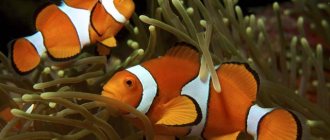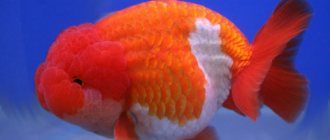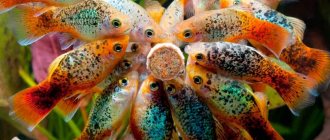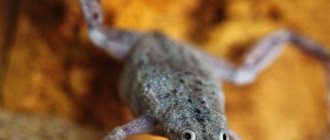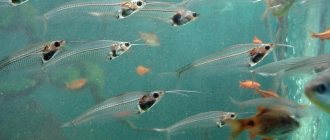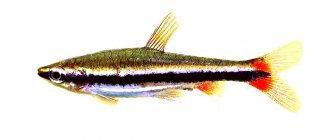Horn belongs to the cichlids - this is a decorative and very bright aquarium fish. She has an interesting character and an unusual appearance. No aquarist will regret having one. Cichlids do not pick and choose partners, which is why many hybrids have been bred. True, not all offspring are successful. Most become infertile after crossing. However, there are exceptions.
The Flower Horn fish from the Cichlid family has an interesting appearance and character.
Flower Horn Information
Cichlids, as a rule, are not picky about partners, and can create pairs not only with their own kind, but also with completely different species of cichlids. This feature made it possible to obtain many completely unimaginable hybrids from different species of fish.
Not all of them turn out successful, some do not shine in color, others, after such crossing, themselves become infertile.
But there are exceptions...
One of the well-known and popular fish in the aquarium is the trihybrid parrot, precisely the fruit of artificial crossing. Also the Flower Horn, he is a child of genetics and the persistence of Malaysian aquarists.
It was in Malaysia that careful selection and crossing of various cichlids (which ones are still not clear for sure) was carried out in order to obtain healthy and reproductive offspring. This is a hybrid, but at the same time it is not prone to disease, is beautiful and prolific.
An interesting feature is that the fish changes its color throughout its life, until it reaches sexual maturity. So, if you are interested in buying bright fish of a certain color, then you need to choose an adult fish, or one that is quite grown up.
Otherwise, you may be in for a surprise, not always a pleasant one. On the other hand, if you buy fry, a whole series of magical transformations will take place before your eyes, and who knows, maybe you will have a fish of rare beauty?
Flowerhorn is very easy to care for; it is an unpretentious and hardy fish. It is worth noting that it grows very large, about 30-40 cm, and requires a spacious aquarium, especially if kept with other fish.
Fish love to dig and eat plants, so you won't be able to create a beautiful aquascape with plants. Because of this hobby, and also because the fish themselves are large, it is recommended to install stones, driftwood and other decor on the bottom of the aquarium, and not on the ground.
Otherwise, they can move them at their discretion.
It is best to keep the Flower Horn alone as a rare, show fish. They are very territorial, aggressive and do not get along well with other fish (except in very large aquariums, from 800 liters).
In other volumes, neighbors will be traumatized or stressed.
Reproduction
Flower Horn reproduces easily in favorable conditions. Although fish of this species can bear offspring as early as 12 months of age, they reach full maturity only at two years. It is worth raising at least a female to this age in order to avoid unnecessary aggression during spawning and achieve strong offspring.
For spawning, the pair is placed in a separate aquarium with a volume of 100 liters or more. The female lays eggs on a smooth surface (a stone, ceramic plate or ordinary plate will do), which she thoroughly cleans beforehand. Horns can lay more than 900 eggs at a time.
If the male is overly aggressive during spawning, then the aquarium is partitioned with a transparent wall that does not reach the bottom. The surface with the eggs should extend slightly beyond the partition so that the male can fertilize the offspring. Make sure that the flow of water goes from the male to the female.
The fry hatch by the end of the second day and after another two days begin to swim. For the first food, small food specially designed for fry, mashed yolk (just do not forget to remove the excess immediately after feeding, otherwise the water will spoil), and brine shrimp are suitable. Horn parents touchingly care for the fry for a little less than a month, then the fry should be placed separately. The fish begin to acquire the color characteristic of this cichlasoma at about six months, at which time or a little later their sex can be determined.
Return to content
Habitat in nature
Flower Horn is a hybrid that was bred artificially and therefore is not found in nature at all. The first individual was bred in Malaysia in the 90s of the 20th century, by crossing several species of fish, mainly cichlids from South America.
They were fascinated by his appearance, especially the fatty bump on his forehead, and they named him "Karoi" - which means warship.
There is still debate about which fish this species originated from. The true combination is known only to those who bred this fish. Aquarists agree that the fish originated from Cichlasoma trimaculatum, Cichlasoma Festae, Cichlasoma citrinellum, Cichlasoma labiatum, and Vieja synspila.
The first line of cichlids to hit the market was called Hua Luo Han. Hua Luo Han were bred around 1998. But since then it has become very popular, and an incredible number of different variations and hybrids have appeared.
With huge fatty lumps (which are enlarged with the help of chemicals), with a shortened body, or curved, and other options.
The most popular at the moment are: Kamfa (KamFa), Malau or Kamalau (KML), Zhen Zhu (ZZ) and Thai Silk (Thai silk).
Flower Horn has received a special, elite status among aquarists. In Asia, along with the arowana, it is considered one of the fish that brings good luck by adherents of the feng shui movement. Feng Shui is an ancient Chinese tradition that normalizes the arrangement of objects and things in the house to achieve maximum harmony with the outside world. And the aquarium in this current is one of the key themes for achieving wealth and success.
Accordingly, a flower horn, the pattern on whose scales resembles a heart or a hieroglyph, can cost thousands and sometimes tens of thousands of dollars.
Even a particularly large fatty lump on the head of a fish can bring the owner a tidy sum. It is believed to be a symbol of the Chinese god of longevity, and the larger it is, the more luck it will bring.
True, more modest fish sell for reasonable prices and are now widely available to aquarists.
Thai silk - young individual:
Origin, appearance and character
Flower Horn is a hybrid cichlasoma of the Perciformes order of the Cichlid family. Horn was artificially bred in the 90s of the 20th century. Judging by the characteristics of the fish, among its ancestors were the rainbow and lipped cichlasomas, as well as citrons and spotted ones. The resulting hybrid is unique: a large (on average 30 cm long, but sometimes growing up to 40 cm) fish with a bright, bizarre color, unusual body shape and complex character, very hardy and not particularly demanding on the composition of water and food.
The Flower Horn's "native" name, given to it by Asian breeders, is Hua Luo Han or Silkfish. In Asia, Horn is considered a talisman that brings good luck and wealth. The fact is that the dark spots on its sides look like hieroglyphs. Individuals with “lucky” signs are very expensive.
The main feature of the horns, in addition to size and color, is the large hump on the forehead, which gives the fish a very “brainy” appearance. The cichlazoma is not deprived of intelligence, but the main component of the hump is adipose tissue. Females have a smaller hump and are duller in color.
Horns have combined and strengthened those character traits that distinguish cichlids from other aquarium fish. They are aggressive, territorial and at the same time very intelligent. Horns are not afraid of people: their aggression extends to hands that are immersed in the aquarium. A fish can bite a stranger very sensitively. But the horn quickly gets used to its owner. He can stroke it and play without fear - the fish will curl around his fingers and rub against his palm.
Description
The Flower Horn has a very dense, oval body with a huge fatty bump on its forehead. Large individuals reach 30-40 cm in length. The scales can be either metallic, gray, or pink or red.
In most species there is a wide, dark stripe along the midline of the body, breaking up into separate spots. But some variations may not have it. The dorsal and anal fins are elongated and pointed, while the caudal fin, on the contrary, is rounded.
Life expectancy is about 8-10 years.
In general, it is quite difficult to describe the appearance of horns. Many aquarists breed their own unique fish. If you buy juveniles, there is a risk that their color will change dramatically as they mature. And, instead of an attractive individual, you will get a rather gray one.
Adult fish are classified according to 7 characteristics: body shape, color, scale size, the presence of a horizontal stripe, the size of a fatty bump, eyes, and straightened fins.
Difficulty in content
Caring for the fish is quite simple, they tolerate water parameters well, which would be a problem for other fish.
They are also unpretentious in nutrition, and eat any protein food, from artificial to live.
It is worth saying that although it seems that this is a suitable fish for beginners, it is still not possible, for several significant reasons.
Firstly, this is a very large fish, which requires a spacious and large aquarium to keep. Secondly, the Flower Horn is very aggressive and territorial; it is advisable to keep it alone, without neighbors or even plants. Beginners can easily find themselves a smaller and more peaceful cichlid.
And finally, the Flower Horn is so aggressive that it attacks the hand that feeds it, inflicting rather painful bites on the owner while he is maintaining the aquarium.
However, if you are absolutely sure that you want this fish, then no circumstances should stop you. Despite the obstacles listed above, this fish is suitable for beginner aquarists as long as they learn their fish and are prepared for some challenge.
Features of the food
Cichlazoma is practically omnivorous; choosing food for them is not difficult. But the legendary color of the horn directly depends on the variety and nutritional value of the feed, which will sparkle with all its richness of colors only if the need for nutrients and minerals is fully satisfied. Now there are many specialized foods for this species, some have special pigments added to increase the brightness of the color. Products from German manufacturers are considered the best, but they should definitely be alternated. Flower Horns happily eat live and frozen food, shrimp, mussels, and dry food. From time to time it is worth alternating them with granules (which are slightly soaked) and flakes.
Feed the fish twice or thrice a day, in small portions. Horn is very voracious, but you cannot overfeed him, like any other inhabitants of the aquarium - the digestive system will not cope.
Return to content
Feeding
This is an omnivorous fish with a huge appetite, which is difficult to feed. They eat all types of live, frozen or artificial food, as long as it contains a high amount of protein.
A variety of food is as important as nutritional value and quality, so it is better to give: high-quality food for large cichlids, shrimp meat, bloodworms, worms, crickets, flies, grasshoppers, small fish, fish fillets, gammarus.
You need to feed two to three times a day, especially if you are feeding food that leaves a lot of waste.
It is important to know that feeding mammalian meat, so popular in past years, is now considered harmful.
Such meat contains a large amount of proteins and fats, which the gastrointestinal tract of fish digests poorly. As a result, the fish becomes fat and the functioning of internal organs is disrupted. You can give such food, but not often, about once a week.
Feeding crayfish:
Keeping in an aquarium
Like other large Central American cichlids, the Flower Horn needs a very spacious aquarium. If you keep it alone, then the minimum volume is 200 liters, but even more is better.
If you keep a pair, then this is already 400-450 liters, and if with other cichlids, then 800-1000 liters. They love moderate currents and clean water; be sure to use a powerful external filter.
Weekly water changes and a bottom siphon are also important, as the Flowerhorn is very littery when eating.
As for the decor, it’s difficult to create - fish like to dig and don’t like plants. There is no point in planting plants in an aquarium at all, they will be destroyed.
It is better to use gravel as a substrate, and large stones and snags as shelters, however, the fish does not like to hide and is quite active.
Make sure that stones, decor and equipment are firmly installed and will not fall, as the horn is quite capable of knocking them over.
The temperature for maintenance should be quite high - 26-30 ° C, pH: 6.5-7.8, 9 - 20 dGH.
What should you prepare for?
The fish has an important feature: the ability to change colors before puberty. If you want to buy a bright and beautiful fish, it is advisable not only to look at the photo, but also to give preference to a grown or adult fish. Otherwise, you need to prepare for any surprise, understanding that it may not be particularly pleasant.
If you manage to buy a small specimen, it will certainly surprise you with its numerous color transformations. Perhaps Flower Horn will grow up beautiful?
Care promises to be easy and straightforward. The fish has a persistent and hardy character. The most important thing is to buy a large aquarium, because the fish will grow to at least thirty centimeters. At the same time, you don’t need to dream of a beautiful aquarium, since the fish likes to dig in the soil and eat plants. Considering both aspects, it is recommended to choose a large aquarium with stones and driftwood placed on the bottom instead of soil. When creating a decent aquarium, it is tedious to remember that it is its inhabitants that can become a real decoration.
Flowerhorn can be kept with other fish. However, it is advisable not to implement this idea in reality. Having studied the photo of the fish, you will be able to understand how beautiful and unusual it is. The best option promises to be aquarium cultivation of one fish, which is an exhibition fish.
Compatibility
Flowerhorns are not suitable for keeping with other fish, as they are very large, aggressive and territorial.
It is best to keep one fish separately or a pair, and if you still want neighbors, then only in a very spacious aquarium. The fish will even attack you while maintaining the aquarium, and the bites will be painful.
To reduce aggression, you need an aquarium with plenty of free space, plenty of hiding places and large neighbors.
Such fish will be: black pacu, plecostomus, pterygoplicht, Managuan cichlasoma, astronotus, giant gourami. But, as a rule, people who keep Horns come to one conclusion - a Flower Horn should live alone!
If you want to breed fish, then remember that its aggressiveness also extends to relatives. Keep a close eye on the couple so that they don't kill each other.
Fight with astronotus:
Sex differences
A reliable method for distinguishing a young female from a male is not yet known.
It is believed that the female has a black dot on her dorsal fin, which is absent in the male, but other aquarists refute this. When sexually mature individuals are ready to spawn, the female has a thick ovipositor and the male has a papilla.
The only technique that can be considered realistic in determining the sex of flowerhorns is the one used by tilapia breeders. Take the teenager, place it in the palm of your left hand, and gently move the palm of your right hand along the abdomen towards the caudal fin.
If it is a male, then you will see splashes of clear liquid from his anus, the female does not have this. An adult male is easy to distinguish by its fatty lump and size.
Breeding
By twelve months, Flower Horn cichlid reaches sexual maturity. For spawning, you should ensure that you have an aquarium with a volume of at least 100 liters, in which the optimal water temperature is 27-28 °C. The female lays up to a thousand eggs on a smooth surface. The pinkish caviar is quite large, approximately 2 mm in diameter. The incubation period lasts about 72 hours. Then, after two days, the fry begin to swim and actively eat. Special dry food for fry in the form of powder, egg yolk and brine shrimp are suitable as starter food. The fry can stay with the breeders for about 3-4 weeks, during which the male and female conscientiously care for the offspring, after which the young should be placed in a separate aquarium. In order to ensure intensive and uniform growth of the fry, they are sorted by size as they grow. At the age of five to six months, the young begin to acquire the color characteristic of adults.
